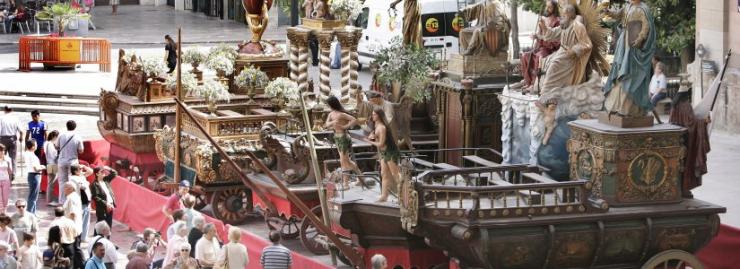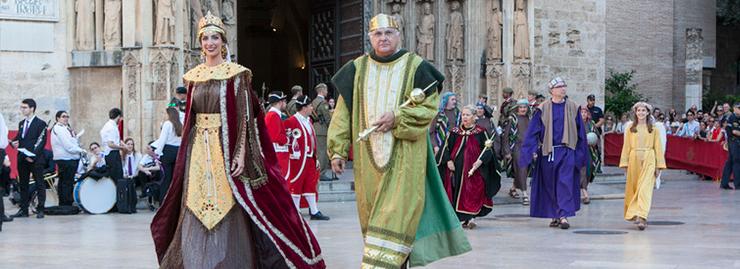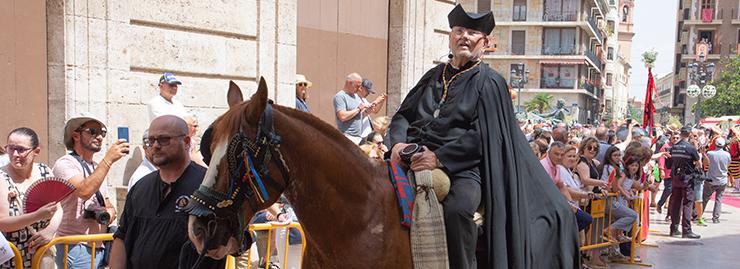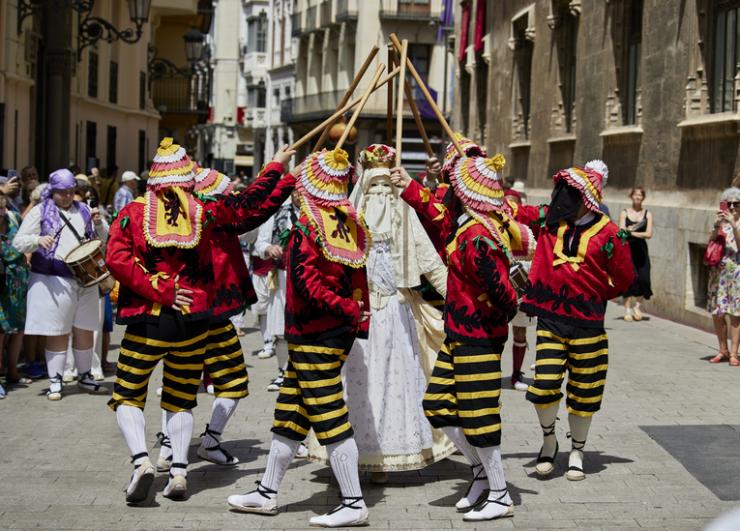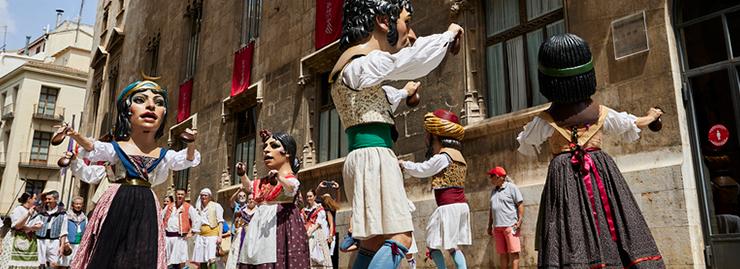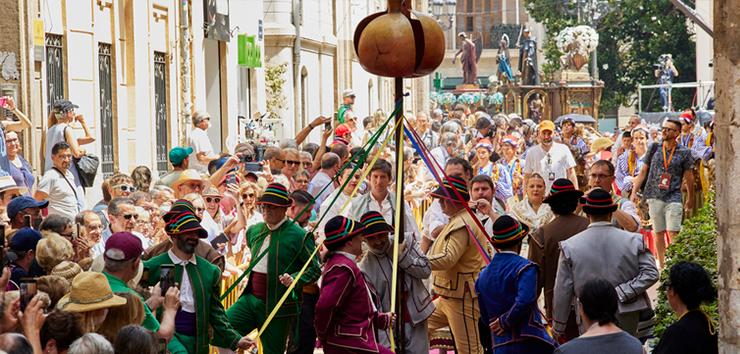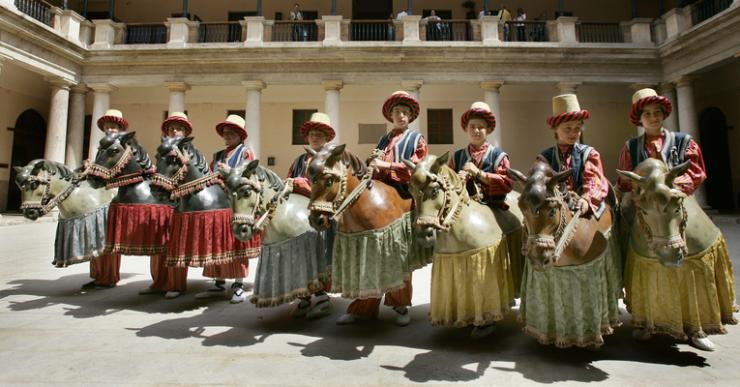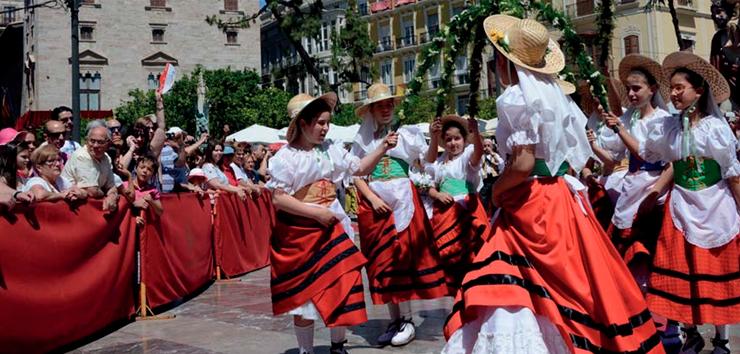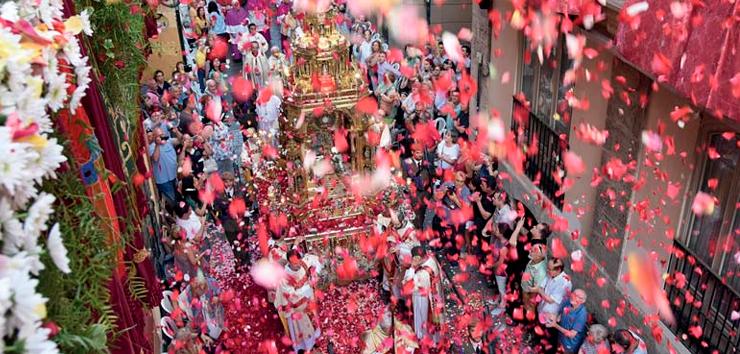Corpus Christi
The festival began in 1263
The Corpus Christi Festivity in Valencia is celebrated on the Sunday of the sixtieth day after Easter. Historically, it has been considered the "Main Festival" of the city. Beyond its purely Catholic meaning, Corpus Christi showcases the coexistence of the festive, symbolic, metaphorical, and religious spirit of Valencian society.
The origin of the festivity dates back to 1263, but it was in 1355 when the Bishop of Valencia, Hugo de Fenollet (who had baptized Saint Vincent Ferrer five years earlier), established the procession. Today, thanks to the excellent work of the Association of Friends of the Corpus Christi of the City of Valencia, the celebration has regained the vitality of its early years.
During the Corpus Christi weekend, the most important events take place, including La Poalà, the Convite Parade, the dances of La Moma and Els Momos, the procession of Las Rocas, and the Solemn Procession. Below, we explain each event so you don't miss a thing.
1. TRANSFER OF LAS ROCAS
On Friday around 8:00 p.m., the transfer of Las Rocas takes place from Alameditas de Serranos to Plaza de la Virgen. Las Rocas are triumphal floats that were originally used to represent "Els Misteris" (Mysteries) during the procession. They consist of eleven wooden structures shaped like ancient ships, carrying sculptural groups that allude to biblical or saintly stories. Their origin dates back to between 1373 and 1392.
On Sunday around 4:30 p.m., Las Rocas are transferred back in the traditional "Paso de las Rocas" parade from Plaza de la Virgen to the Casa de las Rocas. Las Rocas are pulled by horses throughout the route, but there is a special moment when the horses play a predominant role, even more so than the floats themselves.
2. LA POALÀ:
On Saturday at 12:00 p.m., on Cabillers and Avellanas streets, the traditional “Penja de poals” (Hanging of buckets) takes place, where buckets are hung from balconies to "attack" King Herod's soldiers during the Convite Parade the following day. This is one of the most fun moments of the Corpus Christi festivity. Members of the Association of Friends of the Corpus Christi, as they pass through Cabilleros and Avellanas streets, are soaked with water from buckets thrown from the balconies. The joke is returned, and they retaliate by soaking the unsuspecting.
3. REPRESENTATION OF THE MYSTERIES
On Saturday at 6:00 p.m., on the stage in Plaza de la Virgen, the “Representació dels misteris” takes place. This is a set of three short plays dating back to the 15th century, performed by children, representing biblical scenes. The characters later parade in the Convite Parade and the general procession. The plays include the Mystery of King Herod, the Mystery of Saint Christopher, and the Mystery of Adam and Eve.
4. THE CONVITE PARADE
On Sunday at 12:00 p.m., the Convite Parade takes place, representing the invitation made by Valencia’s jurors to authorities and the public to attend the Corpus Christi Procession. Here are some of the most popular characters:
El Capellá de les Roques:
One of the most popular characters represents the Church, whose mission is to invite people to commemorate the festival. He rides a horse covered with a black velvet blanket embroidered with the city's coat of arms and greets those watching the parade from balconies or the street.
THE DANCES
Various groups perform colorful traditional and allegorical dances to the sound of 'Dolçaina i Tabalet'.
La Moma and Els Momos
The most famous of these is 'La Moma i els Momos'. The central character, La Moma (portrayed by a man dressed as a woman in a white robe with his face fully covered by a white handkerchief), battles the seven deadly sins, Els Momos (dressed in black masks, yellow and black outfits, and a distinctive hat resembling a dragon). They perform a striking stick dance that concludes when they surrender to the virtue embodied by La Moma.
The Dance of the “Nanos” and “Gegants":
This ritual has been performed since 1588. In it, four pairs of Gegants (giants) and three pairs of Nanos (dwarves) dance to the rhythm of Tabalet i Dolçaina, performing an ancient dance. The four pairs of Gegants symbolize the adhesion of all known continents to the Eucharist. The combination of Nanos and Gegants signifies that both tall and short people worship the Lord equally.
The Dance of "La magrana"
This dance features dancers dressed in Calabrian style, weaving ribbons around a pole topped by a pomegranate representation that opens at the end of the dance, revealing a monstrance. At this moment, the dancers kneel in an act of Eucharistic worship.
The Dance of "els cavallets"
This dance involves eight boys dressed as Arabs, arranged in two rows of four, each holding a cardboard horse, symbolizing that even non-believers bear witness to their adoration of the Blessed Sacrament.
The Dances of "els arquets", "els pastorets", and "els turcs"
Dances performed by children to the sound of 'Dolçaina and Tabalet'. "Els turcs" perform a warrior dance where pairs simulate a fight with swords.
The dance of "els arquets," originally called the Polacas, symbolizes the joy of the participation of the rural population in the Corpus Christi festivity.
A group of girls dressed as shepherdesses dance with floral arches in their hands, executing various choreographic figures. In the dance of "els pastorets," eight boys perform a stick dance, which is linked to the representation of the Mystery of King Herod.
5. SOLEMN PROCESSION
On Sunday at 7:00 p.m., the Senyera (the city's flag) opens the procession, flanked by "Les Banderoles" or banners. Both the flag and the city's standards are carried by three Kings of Arms with crowned heads, white wigs, and beards. After them, the Archbishop's Cross from the Cathedral and Candlebearers follow. Representatives from several historic parishes and the Guild of Carpenters also parade. A series of biblical and symbolic characters then follow.
Finally, it's time for La Custodia, the most important element of Corpus Christi and the majestic finale of the festival. It appears escorted by a platoon from the Headquarters of the Maneuver Force and flanked by Mancebos (six young men dressed in 16th-century velvet and silk garments). They carry silver spikes and grape clusters. As La Custodia passes by, a dense shower of petals is thrown from the balconies.



